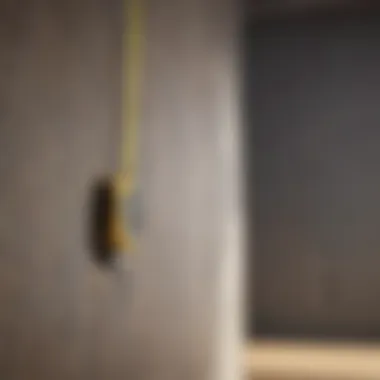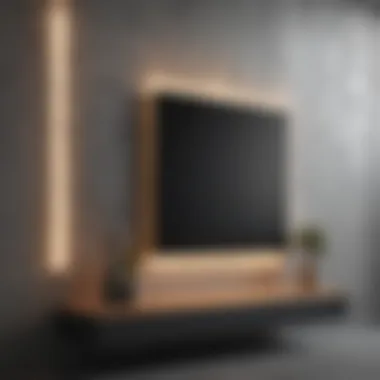Understanding Wall Square Footage in Design


Intro
Accurate measurements require a methodical approach. Basic geometry plays an important role, typically involving calculations based on height and width. However, complexities can arise when architectural features such as windows, doors, or uneven surfaces are taken into account. Understanding these aspects is essential for creating welcoming and functional spaces.
This article will explore varied contexts where wall square footage becomes significant. From practical applications in residential renovations to its implications in property transactions, each scenario sheds light on the value of this measurement. By examining real-world examples and methodologies, the aim is to empower homeowners, designers, and real estate professionals with knowledge and tools they can apply in their respective fields.
Preface to Wall Square Footage
Understanding wall square footage is crucial for both practical and aesthetic purposes in home design and construction. It serves as a foundational metric, impacting decisions related to materials, layout, and design vision. Homeowners, designers, and real estate professionals need to comprehend how square footage affects their projects and investments.
Definition and Importance
Wall square footage refers to the total area of a wall measured in square feet. This measurement includes the height multiplied by the width of the wall, often excluding openings such as doors and windows for more precise applications. Defining square footage accurately is vital because it aids in budgeting and planning. It ensures that the right amount of paint, wallpaper, or tile is purchased, avoiding wastage or insufficient supplies. Additionally, understanding square footage has implications that extend into pricing a home and evaluating its livable area. Therefore, mastery over this concept enhances decision-making for various home improvement projects.
Applications in Home Design and Real Estate
Square footage plays a significant role in interior design as it influences spatial arrangements and functionality. Designers use this metric to determine how furnishings will fit within a given area and how to maximize space efficiently. For instance, understanding the dimensions of a particular wall can help in selecting appropriate artwork or cabinetry that complements the overall aesthetic.
In the realm of real estate, square footage acts as a critical valuation tool. Potential buyers often assess the livable area when making purchasing decisions and negotiating prices. Properties with an accurate representation of their square footage may attract more bidders, leading to a higher sale value. Moreover, during appraisals, certified appraisers rely heavily on square footage calculations to establish the market value of homes. Thus, both designers and real estate professionals must grasp the nuances of wall square footage for effective strategy formulation.
"In real estate, the accurate measurement of square footage can significantly influence a property's market perception and its selling price."
This comprehension of square footage is not only beneficial but essential in the interconnected worlds of design and real estate. It provides a common language for professionals and clients alike, facilitating clearer communication and more informed choices.
Measuring Wall Dimensions
Measuring wall dimensions is a critical phase in understanding square footage. This process sets the foundation for any project that involves construction or design. Accurate measurements ensure that materials are used effectively, budgets are kept in check, and the overall project meets the client’s expectations. When the dimensions of walls are well-understood, it leads to improved planning and execution, which is essential in both home design and real estate evaluations.
Tools Required for Measurement
To get precise wall measurements, certain tools are necessary. Some common tools include:
- Measuring Tape: A flexible tape measure is ideal for quick and accurate measurements of height and width.
- Laser Distance Meter: For those who prefer advanced technology, a laser distance meter offers quick measurements over large distances with precision.
- Level: This is useful for checking if the surface of the wall is even.
- Pencil and Paper: For jotting down the measurements, a simple pencil and paper work well.
Having these tools handy not only simplifies the process but also enhances accuracy, reducing the chances of error later on.


Step-by-Step Measurement Process
Measuring a wall properly involves a systematic approach:
- Prepare the Area: Ensure that the space is clear of furniture or obstructions. This will give you full access to the wall for measurement.
- Use the Measuring Tape or Laser: Start by measuring the height from the floor to the ceiling. Be sure to take measurements at different points to check for any variations.
- Measure the Width: Next, measure the width of the wall, again checking for consistency at different intervals.
- Record Your Dimensions: Write down all the measurements as you go along. This minimizes the chance of forgetting or mixing them up later.
- Check for Irregularities: Once initial measurements are collected, consider any outlets, windows, or doors that may affect your understanding of the available square footage.
Common Measurement Errors to Avoid
Being aware of common errors can significantly enhance the accuracy of your wall measurements:
- Incorrect Starting Point: Always start from a consistent point, whether that is the floor or a designated corner.
- Measuring at an Angle: Ensure that the measuring tape is straight and not twisted, as this can lead to inaccurate measurements.
- Omitting Small Structures: Don’t forget to include small architectural features like ledges or architraves that may affect your calculations.
- Neglecting to Double-Check: Always verify your measurements after taking them. A quick review can save a lot of time and resources.
Accurate wall measurements are fundamental for successful design implementation and effective project management.
Calculating Square Footage
Calculating square footage is an essential task in various fields, particularly in construction and interior design. Understanding how to accurately measure square footage impacts decisions regarding layout, materials, and overall design aesthetics. It serves as a foundation for making informed choices that affect both functionality and cost. Not only does it provide clarity in project planning, but it ensures that resources are used efficiently, which is critical in today’s construction environment.
Basic Formula for Square Footage
To calculate the square footage of a wall, one must use a straightforward formula:
Square Footage = Width × Height
This formula works well for most rectangular surfaces. For instance, if a wall is 10 feet wide and 8 feet high, the square footage calculation would be 10 × 8, which equals 80 square feet. Accurate use of this formula simplifies the initial stages of measuring and estimating.
Adjustments for Irregular Shapes
However, not all walls are perfect rectangles. When dealing with irregular shapes, additional calculations are necessary. Here are some steps to consider:
- Divide the Shape: Break down the wall into smaller, manageable sections. For example, if a wall has a recessed area, calculate the square footage of the main part and the recess separately.
- Use Triangles or Other Shapes: If a section is not rectangular, you can apply specific formulas for triangles or circles. For example, the area of a triangle is determined by the formula Area = 1/2 × base × height.
- Add the Areas Together: Once you have calculated the square footage of each section, sum them up to get the total square footage of the wall.
Incorporating Windows and Doors
When calculating square footage, it is vital to include openings such as windows and doors, as they decrease the total square footage needed for painting or other applications. To accurately incorporate these features:
- Measure the Area of Openings: Measure the width and height of the window or door and apply the basic square footage formula to calculate its area.
- Subtract from Total Square Footage: Deduct the area of the windows and doors from the overall square footage of the wall. If a wall measures 80 square feet and there’s a window occupying 10 square feet, the final usable square footage is 80 - 10 = 70 square feet.
Understanding how to correctly calculate wall square footage helps prevent overspending on materials and ensures design choices align properly.
By utilizing these straightforward methods, individuals can confidently approach their projects, whether they are undertaking renovation, designing a new space, or preparing to sell property. The ability to calculate square footage efficiently can significantly influence the quality and success of interior projects.


Significance of Wall Square Footage
The square footage of a wall directly influences how spaces are designed and utilized. Designers rely on accurate measurements to create visually appealing and functional environments. This metric helps create a balance between negative and positive space, which can enhance the overall comfort and livability of an area. Moreover, knowing wall square footage is crucial for determining how materials are applied, affecting both cost and design efficacy.
Impact on Interior Design Choices
Interior design heavily leans on the concept of square footage. It dictates how furniture is arranged, what types of materials are suitable, and how lighting is distributed throughout the space. A precise understanding of wall dimensions allows designers to recommend the right scale of furnishings, ensuring they fit harmoniously within the room.
Large walls might benefit from expansive artwork or bold color schemes, while smaller walls could require more understated elements to avoid feelings of overcrowding. Designers can also consider the vertical space—often overlooked. Taking wall square footage into consideration aids in promoting an overall cohesive look.
Relevance in Real Estate Valuation
In real estate, wall square footage can significantly impact property valuation. Potential buyers or renters often focus on usable space within a property. The square footage provides a quantitative measure that can differentiate similar properties. A higher square footage often leads to higher value perception, so real estate professionals must accurately convey this information to clients.
When preparing listings, real estate agents must outline the square footage clearly, focusing on how it translates into livable space. This not only helps in setting realistic prices but also assists buyers in making informed choices that align with their specific needs.
Role in Construction Budgets
Construction budgets are inherently tied to wall square footage. Contractors estimate materials and labor costs based on the square footage calculated for walls. Knowing how much space is available allows for more accurate budget forecasts, reducing the risk of overruns.
For instance, if a contractor overlooks wall square footage, they might miscalculate the amount of drywall needed, leading to increased costs and delays. Therefore, the significance of this measurement cannot be understated. Accurate square footage calculations ensure that all resources are appropriately allocated, enhancing efficiency and project outcomes.
"Accurate wall square footage measurements serve as the foundation for effective design, valuation, and budgeting processes."
Practical Applications of Square Footage Knowledge
- Selecting Appropriate Materials
The first step in any construction or renovation project often revolves around material selection. By accurately knowing the wall square footage, homeowners and designers can make informed decisions about the materials to use. For instance, whether opting for drywall, plaster, or wood paneling, having precise measurements helps in determining how much material is required. This minimizes waste and reduces costs, as over-ordering can lead to budget overruns.
When purchasing paint or wallpaper, square footage is equally important. Paint cans typically indicate coverage per gallon, so knowing the wall area helps in purchasing the right quantity. - Designing Functional Spaces
Square footage knowledge can aid in creating spaces that are not only aesthetically pleasing but also functional. Designers can optimize layouts based on the dimensions of walls. For example, in a living room, understanding wall space allows for better placement of furniture, artwork, and storage solutions.
A well-planned room should maintain balance and harmony, which is achievable through accurate measurements. If walls are not correctly measured, the overall functionality of spaces can be compromised, leading to inconvenience and inefficiency in daily use. - Estimating Painting and Finishing Costs
Cost estimation in painting and finishing a wall is often driven by square footage. Being knowledgeable about this metric allows homeowners to gauge labor and material expenses accurately.
For instance, when hiring painters, they typically charge per square foot for labor. Understanding the wall square footage ensures a more reliable budget estimate. Moreover, if any wall treatments are involved, such as texture or special finishes, these also depend on the area being covered.
"An accurate understanding of wall square footage is a vital asset in design and construction, impacting both functionality and costs."
By emphasizing these practical applications, homeowners and designers can better harness the potential of their spaces, leading to more successful projects.
Future Trends in Wall Measurement and Design
The landscape of wall measurement and design is evolving rapidly. This section emphasizes the importance of keeping abreast of upcoming trends, which can significantly impact both efficiency and creativity in interior design and construction. Understanding these trends is not just for professionals; homeowners can also benefit from this knowledge when making decisions about renovation or building projects.


Advancements in Measurement Technology
In recent years, the integration of technology in measurement has transformed traditional practices. Laser measuring devices have become increasingly popular, allowing for precision and speed. Tools like the Leica Disto and Bosch GLM series offer smart features, such as Bluetooth connectivity that syncs with tablets or smartphones. This facilitates quick calculations and even 3D modelling.
Furthermore, augmented reality (AR) apps create an interactive experience. They can project the size of a wall onto a live view of a room, allowing users to visualize proportions better.
- Increased Precision
Advancements ensure that measurements are more accurate. - Efficiency Gains
Faster measurement equates to shorter project timelines. - User-Friendly Features
Many devices allow for intuitive use without extensive training.
Sustainability Considerations in Design
Sustainability is at the forefront of modern design. The wall square footage not only impacts aesthetic aspects but also energy efficiency. Material choices are being guided by their environmental footprints. Recycled and locally-sourced materials are gaining traction in construction and design. Using sustainable practices can enhance the thermal performance of walls as well, leading to reduced energy consumption.
- Green Materials
Examples include bamboo, reclaimed wood, and low-VOC paints. - Energy Efficiency
Well-designed insulation can minimize heating and cooling costs. - Building Regulations
Many regions now mandate sustainability in new buildings, influencing design choices.
Innovative Materials and Techniques
With the constant push for more effective and appealing structures, innovative materials are emerging. Products like aerogel insulation provide exceptional thermal resistance in thin applications. Other techniques include modular wall systems, allowing for quick assembly and disassembly, which is beneficial for temporary structures or environments.
Materials to Watch Out For:
- Smart Glass: This technology automatically adjusts transparency based on the sun's position, enhancing comfort.
- Nanomaterials: These can be used to create walls that self-clean or are highly resistant to damages.
Through careful attention to these advancements, sustainability, and innovation, anyone involved in wall design can significantly enhance their work.
"Staying ahead of trends in wall measurement not only benefits current projects but also sets the foundation for future practices."
Culmination
The conclusion of this article serves as the culmination of our exploration into the square footage of a wall. Understanding the measurements and calculations related to wall space is vital, not just for construction professionals, but also for homeowners and interior designers. It highlights how this metric impacts various aspects from design choices to real estate valuations.
Summary of Key Points
- Definition and Importance: Wall square footage is a critical measurement in any construction or design project. It determines not only the surface area available for decoration but also influences material selection.
- Measurement Process: Accurate measurements involve specific tools and methods that can avoid common errors. Understanding how to measure is fundamental for any project.
- Calculating Square Footage: The basic formula is straightforward, but adjustments for irregular shapes and accounting for features like windows and doors require additional considerations.
- Significance Across Fields: The square footage directly affects interior design choices, adds value in real estate, and influences budget decisions in construction.
- Practical Applications: Knowledge of square footage helps in selecting materials, designing functional spaces, and estimating costs for painting and finishing work.
- Trends and Innovations: New technologies and sustainable practices are shaping the future of wall measurement and design, reflecting changes in consumer preferences and environmental considerations.
Final Thoughts on Wall Square Footage
In concluding this discussion, we reaffirm the significance of understanding wall square footage. It is not merely a number; it embodies a key to unlocking effective design and functional spaces. By knowing how to measure and calculate, one can make informed decisions that enhance aesthetic appeal and optimize functionality.
As walls define spaces in our homes and workplaces, their square footage becomes integral to both creativity and practicality. Moving forward, embracing technology and innovative practices will further refine how we approach wall measurements, leading to smarter, more sustainable designs in the future.
"Understanding wall square footage is essential for transforming spaces effectively."
Additionally, staying informed about real estate trends can enhance one's ability to utilize this knowledge for investment and improvement purposes. Embracing this understanding paves the way toward better design choices and financial benefits.







